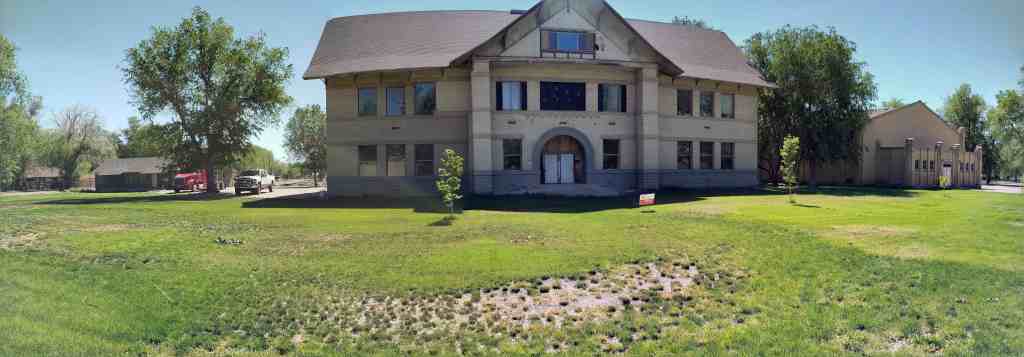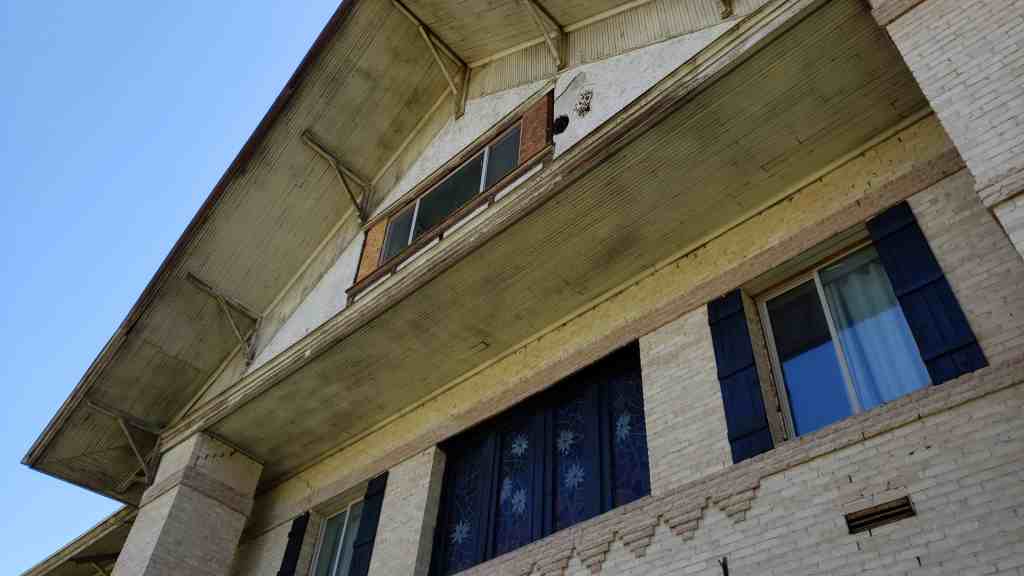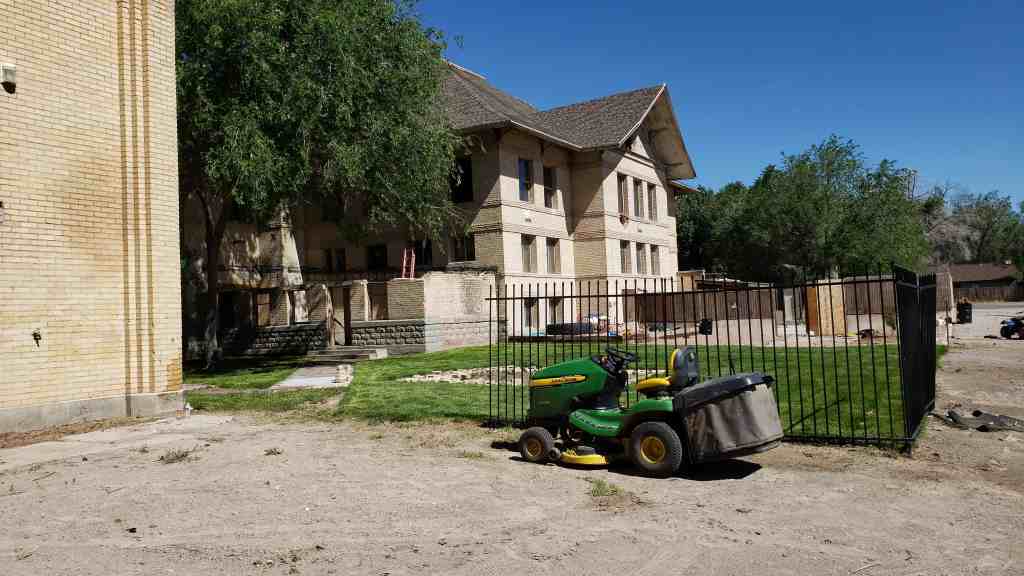Tags
Hinckley, Historic Buildings, Millard County, NRHP, Schools, utah

Millard Academy in Hinckley, Utah was built 1919-1910 by T. George Theobald with S.T. Whicker as the architect, it was the Millard LDS Academy until 1923 and then from 1923 to 1953 it was Hinckley High School.
Related Posts:
- The High School Gymnasium (next door)
- Hinckley, Utah
- NRHP # 82004127
(the text on this page is from the nomination form for the National Historic Register linked above)
The Millard Academy was built from January 1909 to September 1910 as one of nearly three dozen secondary schools that the Mormon Church built between 1875 and 1911 as rivals of both public schools and non-Mormon private schools. It is significant because it helps document the emergence of a secularized public school system in Utah and the adjustment of the Mormon Church to that system. In addition, it is a local landmark, expressing the continuing commitment of the citizens of Millard County to the value of education.

For a generation or so after the settlement of Utah, Mormons, who constituted more than 90% of the population, naturally dominated the territory’s public school system, and religious studies were an integral part of the public school curriculum. By the mid 1870s, however, as the non-Mormon population of Utah began to expand rapidly, the situation began to change. Efforts began to secularize the public schools, and non-Mormon private schools were rapidly established. To counter the “tendencies that grow out of a Godless education,” the Mormon church undertook several measures. It instituted a religion-class movement under which Mormon teachers taught “the Restored Christian Gospel” once a week after regular school hours to all pupils who would come, and it began to establish its own secondary schools. Brigham Young Academy at Prove was founded in 1875, followed by Brigham Young College at Logan in 1877, the Latter-day Saint College in Salt Lake City in 1886, and the Fielding Academy at Paris, Idaho in 1887.
The Edmunds-Tucker Act of 1887 gave added impetus to the Mormon Church’s determination to establish their own secondary school system. Among other things, it required that Utah school laws, which had originally been designed to sanction and support a Mormon dominated public school system, be suspended; that the territorial schools be placed under the control of the territorial Supreme Court and a Court-appointed, and non-Mormon commissioner; and that the financial resources of the Corporation of the Church be disposed of for the use and benefit of the public schools. In response to the Edmunds-Tucker Act, church authorities called upon every Mormon stake to establish an academy in its area. Sixteen were established that first year, and ultimately thirty-five were founded in Utah, and in other states of the Intermountain West, Canada, and Mexico. They were supervised by a church superintendent of schools, a church board of education, and stake boards of education, and were modeled after the Brigham Young Academy in Provo and the Brigham Young College
in Logan. By 1905, more than 60% of Utah’s high school students and a
substantial portion of Mormon high school students in Arizona, Wyoming, Idaho, and Nevada were enrolled in Mormon academies.


The Millard Academy in Hinckley, Millard County, Utah was one of the last to be founded. Only the Dixie Academy in St. George was established later. In the fall of 1908, the church board of education decided to establish an
academy in Millard County.

The choice of location was left to a vote of the Millard Stake High Council
and the bishoprics of each ward in the stake. A lively debate followed over
the location of the academy, with each town in the area lobbying on its own
behalf, though there was widespread feeling that Fillmore, as the county seat and largest town, would probably be chosen. It was not, however, primarily, it seemed, because three saloons, were located in the town. In response to the criticism that tine presence of saloons meant that Fillmore did not offer a wholesome environment for students, the Fillmore town council promised to raise the licensing fee from $400 per year to $1200, thereby to drive the saloons out of business. Finally, however, the town of Hinckley, which had no saloons, was chosen as the site of the academy.

Construction began in January 1909 on eight acres of land near the center of town donated by local resident Joseph W. Blake. He also donated 40 acres of land out of town so that crop yields could help finance the building.

Construction proceeded under the direction of T. George Theobold. An early
settler of Millard County, he was born March 26, 1874 in Duncan’s Retreat,
Washington County, Utah, a son of Arthur and Jane Burgess Theobold. A
carpenter and engineer by trade, lie was involved in the construction of many of Millard County’s early buildings, including the Millard County Courthouse, the Hinckley Elementary School, the Hinckley Relief Society Hall, and the Pratt Merchantile Store. Prominent in local affairs, he served on the Millard County Board of Supervisors, the Millard School District Board of Education, the Hinckley Town Board, and was mayor of Hinckley from 1928 to 1936.

The architect of the Millard Academy was Samuel T. Whitaker of Ogden. Born in Centerville, Utah, December 20, 1859, a son of Thomas W. and Elizabeth Mills Whitaker, he led a varied career, alternating periods of private practice as an architect with other pursuits. He traveled throughout the United States as a sketch artist, became associated with the Boston architectural firm of Paulson and LaVelle, doing field work for them in Utah, Montana, and Idaho; and was the superintendent of the Gibson and Sadler Mill, and then the Barnard and While Mill, both of Ogden. He also served as Ogden’s police chief for six months, and managed the Ogden office of the Utah Light and Traction Company for four years. In addition to the Millard Academy, he also designed the Mormon academies at Alberta, Canada; Oakley, Idaho; and Juarez, Mexico. Other notable buildings he designed include Ogden’s Orpheum Theater, Ogden’s First National Bank, the David H. Peery and the John Browning Houses in Ogden, the Ogden IDS Sixth Ward, and the Farmer’s Free Market in Salt Lake City. With Leslie Hodgson, another well known Utah architect, he designed the Eccles
Building in Ogden. Active in the Mormon Church, he was President of the LDS Scotch-Irish Mission form 1888 to 1890 and first counselor in the Ogden LDS Sixth Ward. Involved in civic affairs, he was a member of Utah’s Food and Fuels Board during World War I and was Director of the Utah State Fair
Association in 1919.”

The Millard Academy was completed at a cost of nearly $55,000, $23,924 of
which was raised by members of the Millard Stake. Each ward in the stake was assessed a certain amount, as follows: Delta, $500; Hinckley, $10,000:
Fillmore, $2000; Deseret, $1500; Oasis, $875; Holden, $1925; Kanosh, $1000; Leamirgton, $1000; Meadow, $1500; Oak City, $1250; and Scipio, $2125.

The Academy opened on September 13, 1910 with a faculty of seven people,
including Principal Louis F. Moench, and 79 students, some from every ward in the stake. By mid-year, there were a total of 141 students.

The program dedicating the academy opened with a prayer, followed with the singing of “We Thank Thee O God for a Prophet,” and featured speeches by Stake President Alonzo A. Hinckley, Bishop Joseph Damron, Jr. and Bishop Joseph L. Stott.

The academy offered three years of work in three fields: normal (teacher
training), domestic arts, and manual training. In addition, it offered special work in music, cooking, sewing, and woodwork, and remedial work for
those too old to attend elementary school. Also, each student was required to take the following religion courses during his three years at the school:
Book of Mormon; Life and Christ and New Testament; Old Testament; and History and Doctrine of the LDS Church.

As the last group of Mormon academies, including the Millard Academy, were being established, public high schools in Utah began to proliferate. Growth was particularly rapid after a 1911 amendment to the Utah Constitution that paved the way for better financing of a statewide public high school system. Thus, while in 1890, only 5% of all secondary students in Utah attended public schools, by 1911, half did, and in 1925, 90%.

As the public school movement grew, the Mormon Church, began to re-evaluate its educational policies. It was reluctant to give up its academies, however, until an alternative way could be found to provide religious instruction to Mormon’s of high school age. In 1912, Church leaders persuaded the Granite School District in Salt Lake City to approve the establishment of an experimental LDS Seminary near Granite High School. There religious instruction would be offered to high school students on a voluntary basis, with “released time” being granted by the school. If successful, such seminaries could provide religious training for LDS students at a fraction of the cost of maintaining regular church schools. Seminary classes began that fall and by the end of the decade had spread to other schools.

As the seminary program continued, the Church worked in close cooperation with state education officials, and in January 1916 the state board of education granted limited high school credit for released-time classes in Bible history and literature. This provided an important boom to seminary enrollment.

In the meantime, the state superintendent of public instruction discussed
state concerns with the Church board of education and urged the Church to
withdraw completely from secondary schools. The money saved, he suggested, could be used to establish good normal schools for teacher training, a seriously growing need in the state.

The Mormon Church was already sympathetic with the idea of better teacher training and especially concerned that public school teachers be well prepared in their academic subjects and also in turn with the spiritual and moral ideals of the Church. As a result of that concern, and the success of the released time seminary program, the Mormon church, in 1920, decided to convert some of its academies into teacher training institutions and transfer the others to local school districts for use as public high schools.

The Millard Academy was one of those transferred to the state, and in 1923
became the Hinckley High School. In 1953. because o£ falling enrollment, the high school was eliminated and for the next 20 years the building housed the Hinckley Elementary School.








My father attended the old Millard Academy when it was a high school. I visited there about ten years ago to see and photograph it but it was run-down and empty. People there said it was “under construction” to remodel it but the city contractor ran out of money and it stopped. Has it now been finished and is used again as a high school?
The photos and video on this page are from May of 2020, there was someone working on it and it looked like it was pretty torn apart for remodeling.
I purchased this place about 10 years ago and have done a bunch of remodeling since. It is a beautiful old building. The entryway and upstairs is where most of the work has been done. We are glad to take people on tours if you knock or call. We have turned this building into our home. 435-764-2779. Kevin Caldwell
That is so cool. I’d love to see inside.
My grandfather also went to this school. I would love to go through it some day. Thank you, Esther Lawotn
I have sold the property and there is new owners.
I attended school in this building in first through fourth grades. Before that, my dad taught here, when it was Hinckley High School, until it was closed in 1953 and the elementary school was moved into the building. I just learned that my great grandmother’s brother, Samuel T. Whitaker was the architect of this grand old building, and I’m glad to see it being preserved.
Does anyone know if there is a 1912 class yearbook or photo ?
I have a copy of the 1913 class yearbook with class photos including my grandmother Iva Turner Stewart and many more local kids.
If you would like to see if your relative has a photo send me names and I will see what I can find.
A copy of class of 1913 photo may be found on familysearch.org under memories for Iva Dell Turner (Stewart)
Any thing on the Ephraim Stewart or Duncan families of Meadow Utah or Turner family of Holden Utah appreciated.
Jonsbaxter@hotmail.com